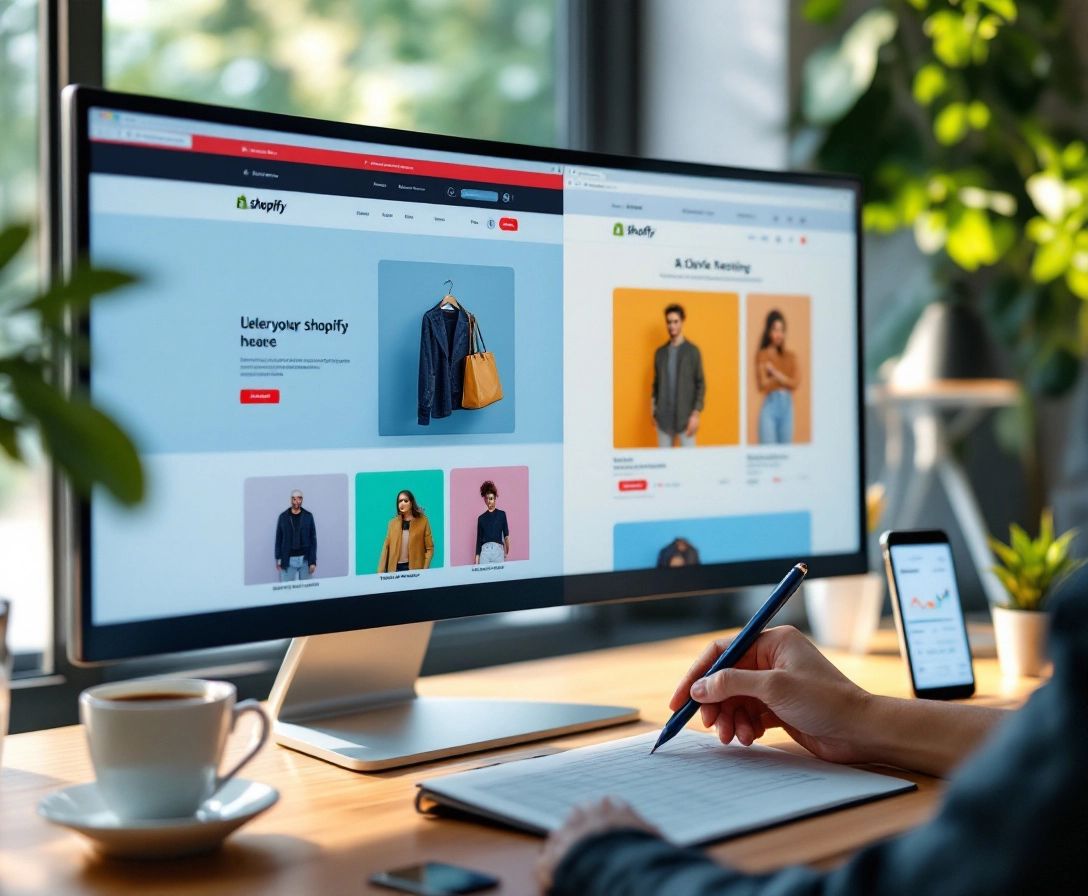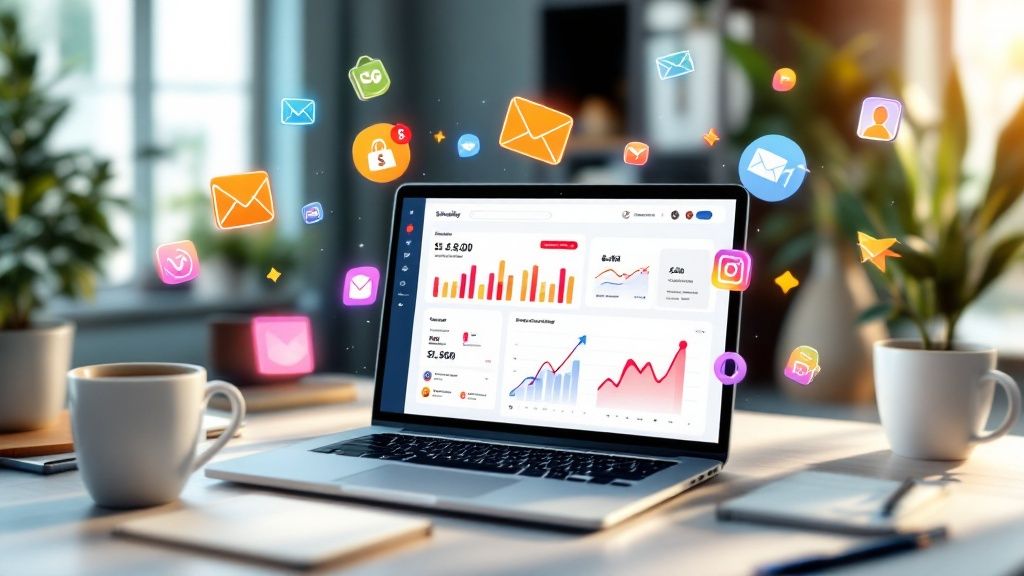Shopify Email Automation: 7 Proven Ways to Boost Sales
May 5, 2025
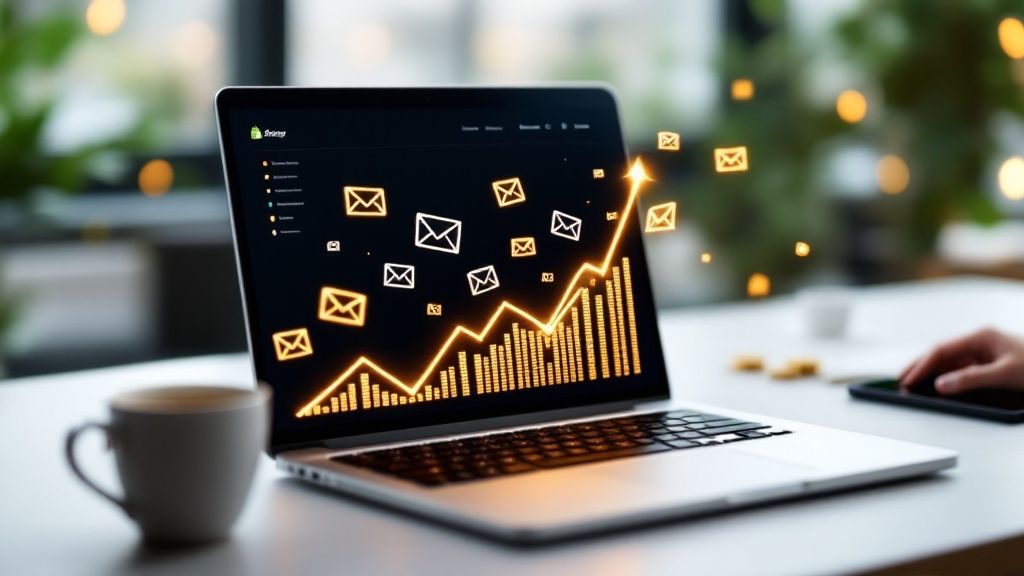
The Hidden Power of Shopify Email Automation

Shopify's email automation capabilities go beyond basic email marketing. They offer a powerful engine for revenue growth, stemming from Shopify's unique integration with your store. This provides opportunities that standalone email platforms simply can't match. The direct link to your product catalog, inventory, and customer history transforms generic emails into personalized revenue drivers.
Why Integration Matters
Instead of separate systems for your store and email marketing, Shopify combines them into a single operational hub. This integrated approach creates efficiencies that directly benefit your bottom line.
For example, imagine automatically sending personalized product recommendations based on past purchases. This level of personalization is possible because Shopify Email has direct access to real-time store data.
This integration is also the foundation for building strong customer relationships at scale. With Shopify Email automation, you can nurture leads, welcome new subscribers, and re-engage past customers, all automatically. This frees you to focus on other business areas while maintaining excellent customer service.
Unleashing the Potential of Shopify Email
This built-in integration allows for sophisticated automation strategies. You can segment your audience based on purchase history, browsing behavior, and other key data points. This allows you to send highly targeted messages that resonate with each individual customer.
For instance, you can send a special discount to customers who abandoned their carts, encouraging them to complete their purchase.
Furthermore, Shopify Email offers exceptional value, especially for small businesses. You can send up to 10,000 emails for free each month. As your business expands, you can upgrade to paid plans with more features and sending capacity. This accessibility makes Shopify Email a practical choice for businesses of all sizes.
Shopify Email campaigns have proven highly effective. In 2025, they achieved an average conversion rate of 4.29% across stores, outperforming search (3.04%) and direct traffic. Automation features like behavior-based triggers and Shopify Flow integrations further enhance this effectiveness. These enable targeted campaigns, such as focusing on VIP customers or recovering abandoned carts, directly from your store’s data. The platform’s drag-and-drop editor and AI content generation simplify campaign creation, with readily available templates for welcome series, post-purchase follow-ups, and inventory alerts. Learn more about email marketing statistics here. This blend of power and accessibility makes Shopify email automation a valuable tool for e-commerce businesses.
Building Your First Revenue-Generating Email Flow
Shopify email automation can feel daunting, but creating your first automated sequence doesn't require advanced marketing knowledge. Let's explore how successful store owners convert casual visitors into loyal customers. This involves using Shopify's email features, designing effective templates, and configuring automated triggers.
Mastering the Shopify Email Editor
Shopify's built-in email editor offers a simple way to create professional emails. It provides pre-designed templates for common situations like welcome emails and order confirmations. These templates are customizable to reflect your brand's identity and style.
You can also create templates from scratch. This gives you complete control over the design and content, allowing you to tailor emails that connect with your specific audience.
You might be interested in: How to master email marketing best practices.
Setting Up Triggers and Timing
With your email templates prepared, you'll need to configure triggers. Triggers are specific actions that automatically send an email. For example, an abandoned cart trigger sends an email to a customer who adds items to their cart but doesn't complete the purchase.
The timing of your emails is essential. Sending emails too often can annoy customers, while infrequent emails can result in missed opportunities. Test different timings to find what resonates with your audience. Consider sending an abandoned cart email 30 minutes after abandonment, followed by another 24 hours later if there's no activity.
Troubleshooting Common Roadblocks
Many merchants face challenges with email automation. A frequent problem is emails landing in spam folders. This is often resolved by verifying your sender email address and ensuring your email content adheres to best practices.
Low open rates are another common issue. Engaging subject lines are crucial for capturing attention. Experiment with different subject lines to see which ones perform best. Clear, concise, and personalized subject lines tend to be effective. For example, instead of "Sale!", use "Exclusive Offer Just for You, [Customer Name]!". Addressing these common challenges will optimize your Shopify email automation.
The 5 Email Flows That Drive 80% of Revenue
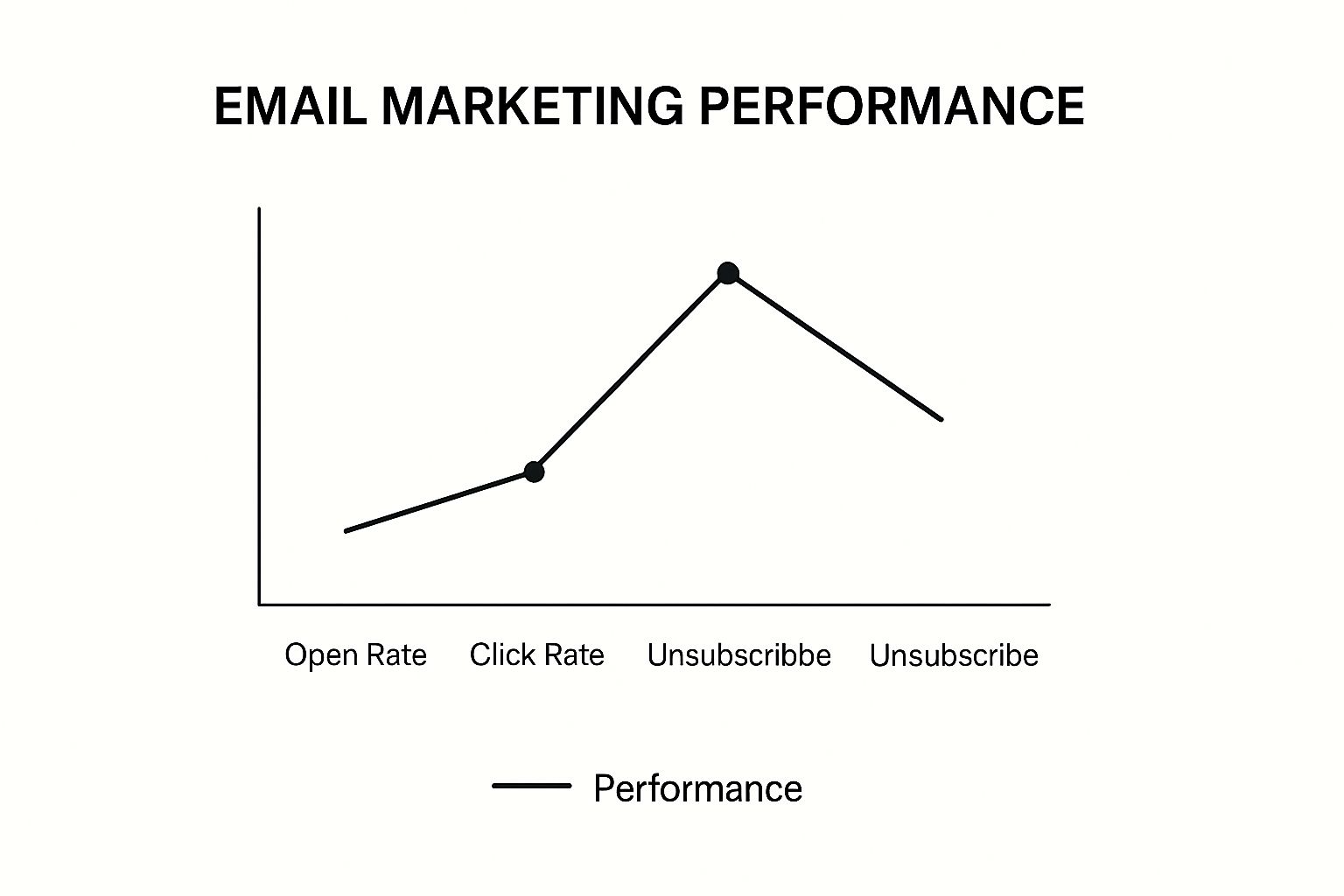
Not all email automation is created equal. Some automated sequences consistently outperform others, generating the majority of revenue for Shopify stores. Let's explore the five email flows responsible for driving a significant 80% of revenue. For each flow, we'll cover templates, timing, and content strategies to maximize your conversions.
1. Welcome Series
The welcome series is the first impression for new subscribers. This sequence greets new customers, introduces your brand, and encourages initial purchases. A well-crafted welcome series can significantly boost early engagement and sales. Offering a small discount in the first email is an effective incentive to drive those first purchases.
This initial interaction sets the tone for your customer relationship, making it crucial to get it right. Personalization can play a large role in welcome series success.
2. Abandoned Cart Recovery
Abandoned carts are a major pain point for e-commerce businesses. This flow targets customers who add items to their cart but leave without completing the purchase. Timely reminders, often paired with limited-time discounts, can effectively recover these lost sales.
A good strategy is sending the first email 30 minutes after abandonment, followed by a second email 24 hours later. This provides a gentle nudge without being overly intrusive.
3. Post-Purchase Engagement
After a customer makes a purchase, the post-purchase flow nurtures the budding relationship. These emails thank customers for their order, provide shipping updates, and offer personalized product recommendations. This strengthens customer lifetime value and encourages repeat business.
Including a discount code for their next order can incentivize future purchases and build brand loyalty. Consider incorporating customer reviews and testimonials to further build trust.
4. Product Promotion & Launches
Launching new products or promoting special offers requires strategic communication. These promotional flows announce new arrivals, highlight key features, and create a sense of urgency to encourage immediate purchases.
High-quality product photography and compelling product descriptions are essential for capturing attention and turning interest into sales. Exclusive previews for subscribers can also generate excitement and drive pre-orders.
5. Win-Back Campaigns
Customer churn is inevitable, but not irreversible. The win-back flow targets inactive customers with personalized offers and incentives to re-engage them with your brand. This can effectively recapture lost customers and reignite sales.
Segmenting inactive customers based on their purchase history and offering tailored discounts can improve the success of win-back campaigns. Understanding why customers become inactive is key to crafting effective win-back emails.
In 2025, automated email flows like abandoned cart and welcome series are major revenue drivers for Shopify merchants. Automated reminders, often including time-sensitive discounts, recover 10-15% of abandoned carts. Welcome flows are particularly effective, with some skincare brands generating direct sales from subscriber lists of just 3,000 recipients. Furthermore, Shopify’s integration with services like Mailchimp allows for personalized product recommendations, boosting click-through rates by 20-30%. More detailed statistics can be found here.
Visualizing Email Flow Performance
The following data chart illustrates the average conversion rates and revenue contribution of each of the five key email flows.
[Infographic will be inserted here]
- Welcome Series: Average Conversion Rate: 5-10%, Revenue Contribution: 15%
- Abandoned Cart: Average Conversion Rate: 10-15%, Revenue Contribution: 25%
- Post-Purchase: Average Conversion Rate: 3-5%, Revenue Contribution: 10%
- Product Promotion: Average Conversion Rate: 2-4%, Revenue Contribution: 20%
- Win-Back: Average Conversion Rate: 1-3%, Revenue Contribution: 10%
As the chart reveals, Abandoned Cart recovery and Product Promotion flows are significant revenue contributors, while the Welcome Series boasts the highest average conversion rate. This underscores the importance of prioritizing these email flows in your Shopify email automation strategy. Tools like Checkout Links can further enhance these flows by creating shoppable links that pre-fill carts and automatically apply discounts, simplifying the buying process. This ease of purchase leads to higher conversion rates and overall revenue growth.
| Automation Flow | Average Conversion Rate | Implementation Complexity | Revenue Impact | Best For |
|---|---|---|---|---|
| Welcome Series | 5-10% | Low | 15% | New subscribers |
| Abandoned Cart Recovery | 10-15% | Medium | 25% | Recovering lost sales |
| Post-Purchase Engagement | 3-5% | Medium | 10% | Building customer loyalty |
| Product Promotion & Launches | 2-4% | Medium | 20% | Driving sales of new or featured products |
| Win-Back Campaigns | 1-3% | High | 10% | Re-engaging inactive customers |
This table summarizes the key performance indicators of each email flow, providing a quick overview of their effectiveness and complexity. The data emphasizes the importance of implementing a diverse email marketing strategy to maximize revenue generation from various customer segments.
Segmentation Strategies That Transform Conversion Rates
Effective Shopify email automation relies on delivering the right message to the right customer. Leading Shopify merchants understand this, using customer data to create targeted email experiences that outperform generic email blasts. This personalized approach significantly boosts engagement and sales. Let's explore how they achieve this.
Identifying Key Customer Segments
Understanding your customer base is the first step. Consider these valuable segments:
-
VIP Customers: These are your most loyal, highest-spending customers. Identify them based on purchase frequency and total spend. Reward their loyalty with exclusive offers, early access to new products, and personalized recommendations.
-
At-Risk Customers: These customers haven't purchased recently. Win them back with targeted offers, personalized product suggestions, or a check-in.
-
Upsell Opportunities: Some customers are ready for additional purchases. Analyze past purchases and browsing behavior to identify products that complement their previous choices. Present these upsell opportunities through targeted email campaigns.
Implementing Dynamic Segmentation With Shopify Email Automation
Shopify lets you create dynamic segments that automatically update as customer behavior changes. This ensures your messages stay relevant.
For example, a dynamic segment for VIP customers could automatically add or remove members based on their spending over the past year. This ensures your VIP list is always current.
Engaging Specific Customer Groups
Once you've identified your key segments, tailor your messaging for maximum impact:
-
Product Enthusiasts: Engage customers who frequently purchase from a specific product category with tailored recommendations and exclusive offers within that category.
-
Seasonal Buyers: Target customers who make purchases during specific times of the year with timely promotions and relevant product suggestions.
-
Location-Based Segments: Offer localized promotions and shipping deals to customers in specific geographic areas.
By implementing these segmentation strategies, your Shopify email automation will feel more personal. This strengthens customer relationships, increases engagement, and drives conversions. Checkout Links allows you to enhance this personalization by creating unique shoppable links for each segment, pre-filling carts with recommended products, and applying exclusive discounts. This can significantly boost conversion rates.
To illustrate how segmentation impacts email performance, let's examine some real metrics. The table below showcases the improvements various Shopify stores have seen after implementing targeted segmentation.
| Segmentation Type | Open Rate Improvement | Click Rate Improvement | Conversion Rate Improvement | Implementation Effort |
|---|---|---|---|---|
| VIP Customer Program | 25% | 18% | 12% | Medium |
| At-Risk Customer Recovery | 15% | 10% | 5% | Low |
| Product-Specific Recommendations | 20% | 15% | 8% | Medium |
| Seasonal Promotions | 12% | 8% | 4% | Low |
| Location-Based Offers | 10% | 6% | 3% | Low |
As you can see, even simple segmentation strategies can lead to noticeable improvements across key email metrics. The effort required for implementation varies depending on the complexity of the segmentation, but the potential return on investment makes it a worthwhile endeavor.
Real-World Examples of Segmentation Success
Many Shopify merchants have seen remarkable results. For example, one apparel brand segmented their customers by preferred clothing style, sending targeted emails showcasing new arrivals within each style category. This resulted in a 15% increase in click-through rates and a 10% boost in conversions.
Another merchant segmented their customers based on purchase history, offering personalized product recommendations. This led to a 20% increase in average order value. These examples demonstrate the power of segmentation.
Supercharging Shopify With Advanced Email Integrations
While Shopify's native email tools offer a solid starting point, integrating with specialized third-party platforms can significantly elevate your email automation. This empowers you to take your marketing to the next level. Let's explore how platforms like Klaviyo, Omnisend, and Mailchimp amplify Shopify's existing capabilities.
Exploring the Shopify Email Integration Ecosystem
Several platforms integrate seamlessly with Shopify, each offering distinct advantages. Klaviyo is renowned for its advanced segmentation and personalization. Omnisend stands out with its omnichannel marketing approach, incorporating SMS and push notifications alongside email. Mailchimp provides a user-friendly interface and a broad range of integrations, making it a versatile option.
The ideal platform for your business depends on your specific needs and budget. A business prioritizing personalized email marketing, for example, might find Klaviyo's powerful segmentation a perfect match.
Choosing the Right Integration for Your Business
Selecting the right email integration depends on several key factors:
- Business Stage: Startups may find Mailchimp's affordability and ease of use appealing, while larger businesses may prefer Klaviyo's advanced features.
- Marketing Goals: If customer loyalty is your primary focus, a platform like Omnisend, with its emphasis on omnichannel engagement, could be a better fit.
- Technical Expertise: Some platforms require more technical setup than others. Consider your team's capabilities when making a decision.
Connecting with merchants already using these integrations can offer valuable insights. They can share their experiences, including the return on investment they've achieved and any challenges they've encountered.
Implementing and Optimizing Your Chosen Integration
Successful integration requires careful attention to several technical aspects:
- Data Syncing: Ensure seamless data flow between Shopify and your chosen email platform. This synchronization is vital for precise segmentation and personalization.
- Workflow Automation: Utilize Shopify's customer data to create automated workflows within your email platform. This might include welcome emails, abandoned cart reminders, or post-purchase follow-ups.
- Testing and Refinement: Regularly test your email campaigns and automated workflows. Track key metrics, such as open rates and click-through rates, to refine your strategy and maximize results.
For instance, Checkout Links integrates smoothly with Shopify and platforms like Klaviyo to streamline the purchasing process. By creating shoppable links that pre-fill carts with selected products and apply discounts, Checkout Links enhances email automation and boosts conversions. This integration simplifies buying, making it easier for customers to complete purchases.
Real-World Examples of Successful Integrations
Many Shopify merchants have seen impressive revenue growth after integrating with advanced email platforms. One merchant, for example, reported a 30% sales increase after implementing Klaviyo and utilizing its advanced segmentation.
Another merchant, using Omnisend's combined email and SMS campaigns, saw a 20% increase in customer lifetime value. These real-world successes highlight the potential of integrating Shopify with specialized email marketing platforms.
By strategically combining Shopify's rich customer data with the powerful tools offered by these platforms, you unlock new automation possibilities. These include:
- Hyper-Personalized Recommendations: Deliver tailored product suggestions based on individual customer behavior.
- Dynamic Content: Show unique content in emails based on real-time inventory or other dynamic factors.
- Automated A/B Testing: Optimize your campaigns by testing different subject lines, email copy, and promotional offers.
These integrations not only drive revenue growth but also reduce your daily marketing workload. Automation streamlines repetitive tasks, freeing you to focus on strategic initiatives. This increased efficiency is a major benefit of using advanced email integrations with Shopify.
Measuring What Matters: Optimizing for Maximum ROI
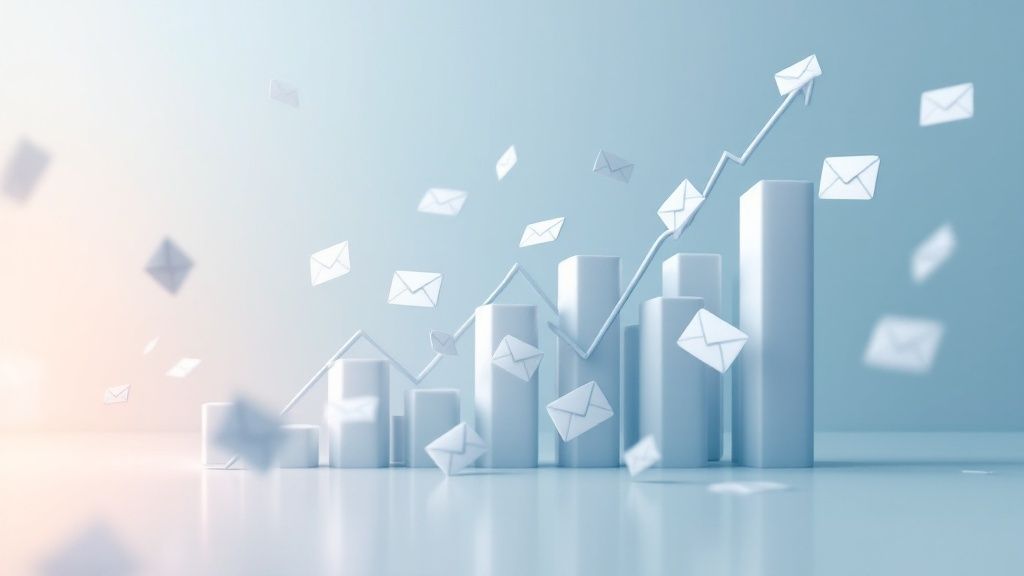
Many Shopify merchants focus on surface-level metrics, missing key opportunities to improve email automation performance. This article provides a framework for assessing automation effectiveness beyond superficial metrics like open rates, focusing instead on data that truly drives revenue growth. We'll explore how to analyze this information and implement changes for ongoing improvement.
Beyond Vanity Metrics: Focusing on Revenue Impact
While open and click-through rates offer some insight, they don't tell the whole story. Instead, concentrate on metrics directly tied to revenue, such as conversion rate, average order value (AOV), and customer lifetime value (CLTV). Focusing on these metrics provides a much clearer picture of your email automation’s true impact on your bottom line.
For example, a high open rate doesn’t guarantee increased sales. A lower open rate combined with a higher conversion rate might actually be more profitable. This underscores the importance of prioritizing revenue-driven metrics.
A/B Testing for Shopify Email Automation Success
A/B testing is crucial for optimizing your automated email sequences. Test different elements within each flow, including subject lines, email copy, call-to-action buttons, and promotional offers. Analyzing the results of these tests reveals what resonates with your audience and allows for data-driven improvements.
Testing two different subject lines, for instance, can reveal which one leads to higher open rates and, ultimately, more conversions. Experimenting with different discount offers can help determine the optimal incentive for maximizing sales. For more tips, check out our guide on How to master email automation best practices.
Interpreting Data and Implementing Strategic Refinements
Properly interpreting the data from your A/B tests is essential. Look for statistically significant performance differences between variations. These insights will guide your optimization efforts, allowing you to make informed decisions.
Implementing these changes requires a systematic approach. Start with small adjustments and track their impact before making larger changes. This iterative process helps fine-tune your email automation for maximum ROI.
Case Studies: Real-World Examples of Optimization in Action
Examining how other merchants have improved their results offers valuable lessons. One Shopify store increased its abandoned cart recovery rate by 15% simply by adjusting the timing of their abandoned cart emails and adding personalized product recommendations.
Another store achieved a 10% increase in AOV by incorporating upsell offers into their post-purchase email sequence. These examples demonstrate how strategic refinements can dramatically improve performance. Checkout Links can streamline this process by creating targeted shoppable links for A/B tests, simplifying the buying process and boosting conversions.
Mastering Metrics for Different Automation Types
Different automation types require different optimization strategies. For instance, welcome series emails should focus on building brand affinity and encouraging first purchases, while abandoned cart flows aim to recover lost sales. This means the most important metrics will vary depending on the specific automation.
Understanding which metrics matter most for each type of flow allows you to tailor your optimization efforts for maximum impact. By focusing on the right data and implementing strategic refinements, you can transform your email automation into a powerful revenue-generating engine, contributing significantly to your overall business success.
Future-Proofing Your Email Automation Strategy
The email automation landscape is constantly evolving. For Shopify merchants, staying ahead of the curve offers a significant advantage. This section explores emerging trends in e-commerce communication, from AI-driven personalization to predictive send-time optimization, all within the Shopify ecosystem. We'll discuss how to prepare your store to benefit from these advancements and address the growing importance of balancing personalized marketing with customer privacy.
AI-Powered Personalization and Predictive Send Times
Artificial intelligence (AI) is transforming email automation. Imagine sending emails exactly when customers are most likely to open them. This is the potential of predictive send-time optimization. AI analyzes customer behavior to pinpoint the optimal sending time for each individual, maximizing open rates and engagement.
AI also enhances personalization. Instead of generic product recommendations, AI can suggest items based on individual browsing history, past purchases, and even real-time activity. This targeted personalization creates more relevant and engaging email experiences.
Shopify is continually evolving its email tools. Staying current with these changes is essential for remaining competitive. Subscribe to Shopify’s blog and follow relevant industry publications to stay informed about new features and best practices.
Balancing Personalization With Privacy
As personalization becomes more refined, so does the need for responsible data management. Customers want personalized experiences but are also increasingly concerned about their privacy. Building and maintaining customer trust is crucial.
Transparency is key. Clearly communicate your data privacy practices to your customers. Explain how you collect, use, and protect their information. Empower customers by allowing them to manage their email preferences and opt out of personalized marketing. This builds trust and fosters a positive customer relationship.
Building an Adaptable Email Automation Framework
To future-proof your email automation, build a flexible framework. This framework should allow you to easily adapt to new technologies and changing customer expectations.
Here’s how:
-
Modular Design: Create separate email modules for different purposes, such as welcome messages, product promotions, and abandoned cart reminders. This modularity allows you to easily combine and rearrange these modules to create new automated flows.
-
Data-Driven Optimization: Regularly monitor your email performance metrics and use the data to inform your decisions. Test different strategies, track the results, and refine your approach accordingly.
-
Stay Informed: Stay up-to-date with industry trends and new features within the Shopify ecosystem. This awareness helps you anticipate changes and adjust your strategy proactively.
By focusing on these key areas, you can create a Shopify email automation strategy that remains effective as the e-commerce environment evolves. This proactive approach positions you for long-term success in the competitive world of online retail. Ready to improve your Shopify email automation? Checkout Links helps create personalized, shoppable links that boost conversions and recover abandoned carts. Integrate seamlessly with your existing email flows and start seeing results today!
 Checkout Links
Checkout Links
